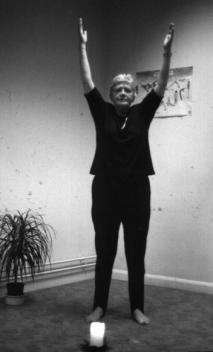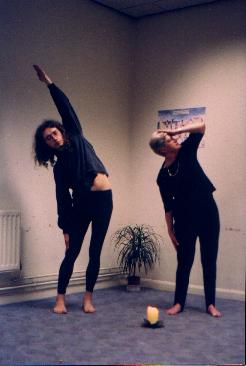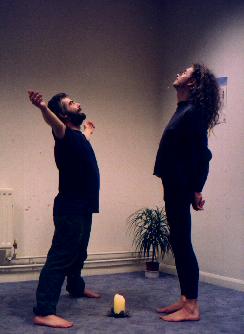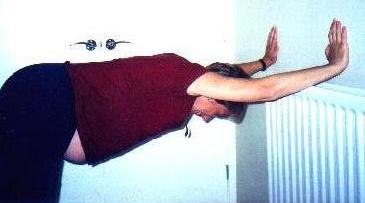7 Way Stretch
Spectrum (The British Wheel of Yoga Magazine)

Yoga is basic, practical and down to earth, one of its many beauties is that we can adapt asanas to the needs of the individual. Its very basis is about the concept of energy and the essence of stillness that we can achieve within that energy.
I am fortunate enough to work with a wide variety of groups including people with learning disabilities, the mentally ill, children, pregnant women and of course those in adult education.
A number of years ago I started putting together the basic postures that we use in yoga to form a sequence that could be practised by all of the range of groups that I work with. The sequence varies according to the group but there is the same underlying theme. Thus the 7-Way Stretch was born! It consists of:
- Stretch number one - The Standing Stretch
- Stretches number two and three - The Twist
- Stretches number four and five - The Side Bend
- Stretch number six - The Backward Bend
- Stretch number seven - The Forward Bend
The sequence is put together bearing in mind both sthira and sukha and the concept of working with one's energy in a positive, constructive and creative way.
Each posture flows from one movement to the next and can be practised dynamically or statically. The role of the breath from one posture to the next is key.
The exception with this is when one works with children and learning disabilities. We are working in a different way and so I often bring in humming and movements as opposed to breath and movement. This again takes time to build up to.
Each posture is broken down into how it can be adapted to a particular group of individuals and their specific needs and within that how it can be adapted to specific individuals.
Many of the 7-way stretch sequences that I teach are now on handouts and I include them on a regular basis in my classes, often weekly as an integral part of the session. It then becomes a specific set of movements that the students get to know well, it is something they can practise at home and won't take out a long section of the day (we all know the 'I haven't got time to practise yoga at home' expression). It is working towards quality and refinement of movement and breath and of course feeling good!
We are all familiar with the set of movements shown here, and probably include each of them in every class that we teach, thus by putting together the 7-way stretch as I call it I haven't done anything special. The significance is that one can move from one posture to the next in a creative way. The body feels stretched, the mind feels still,. one's energy is channeled positively and creatively.
In The Wheel these days we are very hot on safety - and quite rightly so. However, workiiing inn a safe way doesn't mean that we lose sight of the spirit of each individual asana, that has to be paramount.
Any yoga teacher worth their salt should be able to adapt every classical asana - well most - to the needs of the student. If we can work on the basis that the perfect asana does not exist, that there isn't anybody out there who can't do yoga, that asanas can be modified, then we can tailor yoga to every individual's needs. It is a case of keying into the group we are working with and then the individuals within that group.
Whether one is a pregnant woman, in a wheelchair, a nine-year -old child or someone who has practised yoga for 20 years, each of these individuals likes to feel that they have worked with their bodies and their breath to the best of their abilities. As yoga teachers we need to take into account not only our students' physical and spiritual needs but also their emotional needs. We are looking at and working with the whole person. The 7-way stretch is basic, it is a few asanas put together to form a whole, but it is tangible. The feedback is that it makes individuals feel good and at the end of the day that is what is important, whether you are eight or 80!
How to do the 7-Way Stretch
TADASANAWeight evenly balanced between both feet, feet about two feet apart, tuck the tailbone under, tone the abdominals, don't let the top part of the body sink into the bottom part, let the spine extend right to the top of the neck, let the shoulders drop, let the arms be loose. STRETCH 1INHALE as take arms up and go up onto toesEXHALE as increase stretch and heels come downINHALE into stretch EXHALE as arms come slowly down. |

|
|
STRETCHES 2 & 3 SIDE BENDINHALE as look to the left, place left hand on forehead; EXHALE as you slide your right arm down; INHALE as come back to centre EXHALE as release left arm and lower, head back to centre. Stretch from the top of the hip, be sure the tailbone is tucked under and abdominals toned. This is a side stretch, the body should not go to the front or back. For STRETCH 3 repeat on the other side. |
 |
|
STRETCHES 4 & 5 - TWISTINHALE as stretch arms out to the side from the shoulders; the chin should he in line with the breastbone throughout, the hips to the front. EXHALE as twist to one side, arms in a line, chest open. INHALE as come back to centre. EXHALE as lower arms down. For STRETCH 5 repeat on the other side. arm by your side. |
|
STRETCH 6 - BACKWARD BEND
This should be practised gently but effectively. INHALE as clasp hands behind back and stretch up, take the head back just enough to feel a gentle stretch in the front of the neck, you should not feel the weight of the head. Stretch slightly from the base of the spine to the tip of the neck. Do not arch the back, keeping the chest open.
EXHALE as you come back to centre.INHALE tucking tailbone under and toning the abdominals.

STRETCH 7 - FORWARD BEND
EXHALE as bend forward, hands gently clasped behind back, knees bent, back should be parallel to the floor, extend spine, open chest, chin should be in line with breastbone. ON NEXT EXHALATION with back flat go all the way down to the knees, let go of hands.
INHALE as you slowly uncurl and come back to centre.
This set of movements should be practised as a whole. Throughout the movements be aware of having the tailbone tucked under, the abdominal muscles toned, the chest and shoulders open. Work slowly and gently, breath and movement working together. Most of all enjoy the movements.


